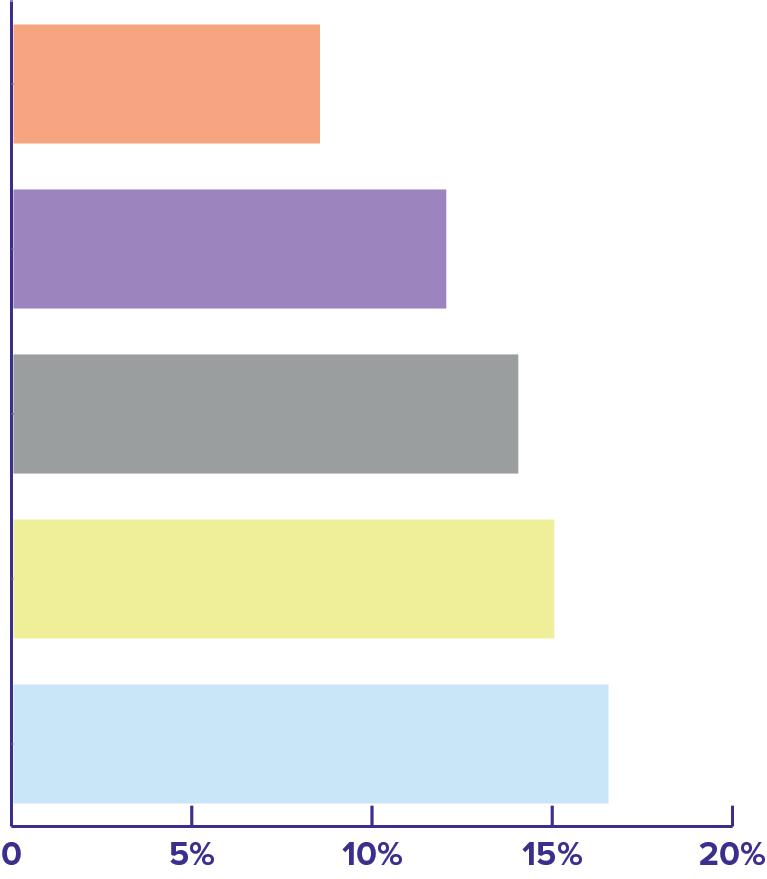
8 minute read
The Danger of Psoriatic Disease
from NÁZEV - TEST

Depression and anxiety, and how to decrease the risk


























Depression and anxiety are the most common mental disorders worldwide. It is estimated that 3.4% of the world population lives with depression and 3.8% with anxiety14. Anyone can develop depression or anxiety at some point in life, but some individuals are at increased risk.
The non-curable, chronic nature of psoriatic disease, the systemic inflammation occurring in the body, and the fact that the disease is visible on the skin renders people living with psoriatic disease at risk of developing depression and anxiety.
But there is hope. Knowing the link between psoriatic disease and depression or anxiety can help people living with the condition and their families identify the early signs of poor mental health. It can also encourage doctors to recognize cases of anxiety and depression in their patients and understand how to intervene.
Depression
According to the WHO, depression is a common condition affecting more than 264 million people worldwide15. Depression is described as a state of persistent sadness and lack of interest or pleasure in activities that were previously enjoyable or rewarding. Depression impacts daily life, relationships, and social interactions. Depression can also cause physical problems, and it is considered one of the leading causes of disability worldwide14-16, as it may impair the ability to work and is associated with long sick leave periods.
Research shows that people living with psoriatic disease are more likely to suffer from depression compared to people that do not have psoriatic disease. A review of published scientific studies concluded that more than a quarter of people living with psoriatic disease show symptoms of depression, and one in ten shows signs of clinical depression17. Studies conducted in different geographies confirm the global trend: 8.5% in Malaysia18, 15% in Singapore19, 12% in Europe20, 16.5% in the US21, and 14% in Latin America22 have been diagnosed or have shown signs of depression. Psoriatic disease has the highest prevalence of depression compared to other dermatological conditions23-25
Psychosocial factors related to having a visible disease partly explain the increased risk of developing depression. Stigma and self-stigma experienced by people with psoriatic disease undermines self-confidence and exacerbates depression. When people have psoriatic disease and another comorbidity at the same time, it is an additional burden on mental health. Living with more than one noncommunicable disease has been shown to be associated with an increased risk of depression, and this seems to be the case in people living both skin and joint symptoms of psoriatic disease25-28
The relationship between psoriatic disease and depression is bidirectional: psoriatic disease can cause depression, and depression can cause psoriatic disease29-32. In fact, science has started to uncover the molecular mechanisms behind the association between psoriatic disease and depression. Inflammation seems to be the link. Some of the same inflammatory mediators are implicated in both psoriatic disease and depression30,33
There are segments of the patient population at increased risk of developing depression. This should be taken into account by health care professionals in their dialogues with patients. For example, women and young people are more prone to develop depression in connection with psoriatic disease, and thus deserve special attention28,31
In the worst scenarios, the feeling of helplessness experienced when living with psoriatic disease can lead to suicidal ideations and behavior. A review of scientific literature found that people with psoriatic disease are more than twice as likely to experience suicidal thoughts. They also have more non-fatal and fatal suicide attempts than people without psoriatic disease34. However, other analyses did not confirm these results35. Therefore, it is difficult to draw conclusions. More studies are needed to understand the risk of suicidal ideation and behavior in people living with psoriatic disease. Studies agree that being young and having a more severe disease increase the risk of having suicidal thoughts34,35
Everyone deserves to have their mental health taken seriously. A timely evaluation of signs of depression eases the burden of psoriatic disease and saves lives. Depression makes it harder for people to focus on improving their psoriatic disease and impairs adherence to treatment, so signs of depression must be addressed before and during therapy. Moreover, timely and proper treatment of psoriatic disease improves depression: it has been shown that certain biologic medications improve psoriatic disease and decrease depressive symptoms and suicidality35. This may be due to the effect of the medications on the inflammatory pathways shared by psoriatic disease and depression. It may also be the result of seeing the symptoms of psoriatic disease improve quickly and extensively36
Anxiety
According to the American Psychiatric Association, anxiety is a normal reaction to stress, helping people to be alert and react in dangerous situations37. Issues arise when the feeling of anxiety becomes excessive and persistent. Anxiety can cause physical symptoms such as increased blood pressure, rapid heartbeat, sweating, or dizziness. Anxiety and related disorders can cause people to avoid situations out of worry38
Studies consistently show that people living with psoriatic disease have an increased prevalence of anxiety compared to people without psoriatic disease. A review analyzing studies on the prevalence of anxiety in people with psoriatic disease reports a prevalence ranging from 7% to 48%39. Much like depression, psoriatic disease can cause anxiety, and anxiety can exacerbate psoriatic disease29. The co-existence of skin lesions and joint symptoms increases the prevalence of anxiety26, but there seems to be no correlation between the risk of developing anxiety and the severity of psoriatic disease25. Itch, a significant symptom of psoriatic disease experienced by many, increases the levels of anxiety40. Similar to depression, anxiety disorders have a molecular signature that partly overlaps with psoriatic disease. A variety of treatments for psoriatic disease can also improve anxiety25,39
The COVID-19 pandemic has exacerbated stress, fear, and anxiety in the general population all around the world40. Fear of contracting the virus causing COVID-19, worries about the consequences of the pandemic on jobs and the economy, and isolation due to the reduction in social contacts has impacted many people. A systematic review of data from more than 200 countries published in 2021 showed an increase of depressive and anxiety disorders due to the pandemic42.
Stress and anxiety exacerbated by the COVID-19 pandemic have challenged people living with psoriatic disease. In a study conducted in China in 2020, people with psoriatic disease reported a worsening of mental health. Depression, anxiety, stress, and insomnia were experienced more frequently during the pandemic compared to the times before the pandemic43 However, other surveys conducted in Germany44 and preliminary results from the UK45 did not find changes in the burden of mental conditions before or during the pandemic. A global survey of more than four thousand people living with psoriatic disease conducted by the research group PsoProtectMe showed that almost half (43%) of respondents living with psoriatic disease have seen their disease becoming worse during the pandemic. Of those reporting worsening of disease, 47% had symptoms of anxiety and depression, compared to 29% with no worsened disease46,47. Individuals reporting worsening of the disease were more likely to live with other comorbidities, be females, and adopt a shielding behavior such as minimizing in-person contacts and not leaving home. Discontinuation of treatment was another cause for worsening of psoriatic disease during the pandemic: living with an immune-mediated disease treated with medicines suppressing the immune system was worrying for many, especially at the beginning of the COVID-19 pandemic, when the relationship between immunomodulatory drugs and likelihood of contracting the virus causing COVID-19 was still unknown. Care for people living with chronic conditions was impaired while resources shifted to respond to COVID-1948,49. For psoriatic disease, canceled appointments50 and initial hesitancy with immunomodulatory therapy51–53 has compromised care and may have triggered lasting consequences.
How much does it cost to have depression and anxiety in addition to psoriatic disease?

Having depression or anxiety together with psoriatic increases costs for individuals. A recent study conducted in the US found that the annual cost of having psoriatic disease and depression is 8859 USD higher than having psoriatic disease alone. For anxiety, the increase in cost is 3018 USD54. The costs rise even further if indirect costs, such as short-term disability and absenteeism from work, are also taken into account: people with psoriatic disease and accompanying depression and/or anxiety lose more workdays due to absence or short-term disability compared to people with psoriatic disease only.
This study reaffirms older studies noting a significant increase in costs and health care utilization by people with psoriatic disease and additional depression and/or anxiety55–57
Considering the evidence that timely and proper treatment of psoriatic disease decreases the risk of developing anxiety and depression, achieving optimal treatment would not only translate to a lighter burden for the individuals, but would also save the costs of treating mental health conditions on top of psoriatic disease.

Acting On Mental Health
Mental health is an integral part of health and well-being. At the 65th World Health Assembly in 2012, world leaders formally recognized the importance of emotional well-being to achieve the highest attainable standards of health. Policies and national action plans are slowly being adopted, but there are significant inequalities in the implementation of such plans globally58.
Just as for physical health, mental health is influenced by many factors, including social and economic determinants, living standards, working conditions, and social support. For example, people experiencing discrimination and human right violations are particularly vulnerable to mental conditions.
Even physical health influences mental health, and vice versa. People living with mental conditions like depression are at higher risk of dying prematurely from other diseases because they tend to postpone seeking help for physical conditions. At the same time, living with a noncommunicable disease also negatively impacts mental health.


Global targets from the Comprehensive Mental Health Action Plan 2013-2030
80% of countries will have integrated mental health into primary health care, by 2030.
The WHO has published numerous tools to aid member states in promoting, preventing, and treating mental conditions. One of the most valuable tools is the Comprehensive Mental Health Action Plan 2013-203059. This plan focuses on four objectives and targets:
1. Strengthen effective leadership and governance for mental health
2. Provide comprehensive, integrated and responsive mental health and social care services in community-based settings

3. Implement strategies for promotion and prevention in mental health
The global rate of suicide will be reduced by one-third, by 2030.
4. Strengthen information systems, evidence and research for mental health
80% of countries will have a system in place for mental health and psychosocial preparedness for emergencies and/or disasters, by 2030.
The plan pushes for the inclusion of mental health services in programs for noncommunicable diseases, and for such services to be covered by universal health coverage schemes. There is a lack of health workers sufficiently trained to provide quality services and prescribe medications for mental conditions. Moreover, some sectors of the health system, such as primary care, are not sufficiently equipped to offer mental health support to those in need.
Suicide prevention is a cornerstone of the WHO plan. It is estimated that 800 000 people die by suicide every year, one death every 40 seconds60. The plan sets a target of halving the number of suicides by 2030 by acting on prevention especially among vulnerable populations, such as young people.
A lot can be done to achieve the plan’s targets by paying special attention to people living with psoriatic disease. Knowing that this segment of the population is particularly vulnerable to mental conditions and experiences many situations exacerbating poor mental health, offering mental health services to people with psoriatic disease will improve the lives of millions of people worldwide and will help governments achieve the WHO targets on mental health.





